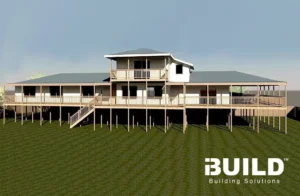Raised Foundations vs Slab Foundations Homes
iBuild kit homes can be built on either concrete slab or raised foundations. So which one is better? Well, that would depend on your site condition.
Concrete Slabs
When building a home there are two primary methods of foundation. In 2020 it is most common for builders to use a concrete slab as the foundation for a house. This is usually the cheaper option on relatively flat site and is faster to construct when rolling out homes quickly. Any services to the building such as water and sewage connections are put into place before the slab is poured and essentially locked into place. This is not an issue typically but a number of difficulties do arise from this including difficulty in relocating services set within the slab and the potential for improper drainage around the slab causing “heaving” (slab movement) which may result in services being broken out of the slab. Although not a common occurrence when this happens it is a highly difficult repair process that can become quite expensive as a jackhammer is required to remove parts of the slab to access and repair services.

Raised Foundations
The next most common method of foundation with homes is a raised foundation. This can come in many forms such as propping the building structure up on concrete blocks or piers and supporting the outer edges with concrete, brick or some other solid material. Historically houses could also be raised on timber stumps to the same effect but this can lead to issues with the timber stumps rotting or being attacked by termites which requires expensive treatment or repairs.

Advantages of Raised Foundations
Raised homes can easily be implemented on sloped properties as each of the supports do not have to be the same length. As such, it is straightforward to construct a home without having to undergo extensive works to level the property prior to building your home. In flood prone areas your home will have an added level of protection as it will be raised off the ground and hence, significant flooding would have to occur just for the water to reach the bottom of your doors.

Raising your home will also allow for greater access when work is required under your home. This allows greater flexibility in relocation of services and also simplifies any repairs that may be required, resulting in cheaper and faster solutions when things go wrong. Many people also find raised foundations more comfortable to walk on with ground level moisture not being transmitted into the flooring and living spaces. This means that you will not have the same cold floor experience as houses with a slab foundation.

Advantages of Slab Foundations
A concrete slab foundation can be considerable easier to install than a raised foundation. Innovation over the past 10 years has led to this becoming the primary method of home foundation that can be seen in rapidly growing suburbs. Once the concrete has been sealed and finished there are minimal issues with a slab, as they are very hard to damage. This means that your home will be unlikely to require much, if any, foundation maintenance. On the interior, a slab can be polished and exposed as flooring or can have tileds, carpet or floorboards installed on top for a more conventional look to your home. It is also impossible to install elements within your slab to heat your floor during the cold winter months however, this is normally an additional cost and a decision that must be made early in your home construction process.
Conclusion: Raised Foundations or Slab Foundations?
There are significant advantages to both methods of home foundation and there are several factors that are important to consider when making your decision. The most important of which is to consider the environment in which you are building your home. A home that is built on a sloped site or in an area prone to flooding may benefit from a raised foundation, but a home built in an area with mold, or termites would likely benefit from a slab foundation (and possibly a steel frame if exposed to termites).
Author: Marcus Rzanovski
Related article: Pole Homes – Pros and Cons
